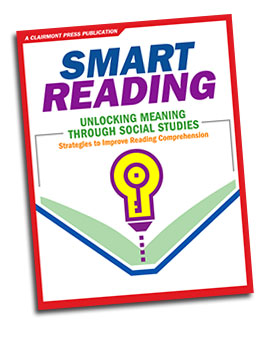Smart Reading

Strategies to improve Reading Comprehension
Students begin to read at an early age. By middle school most students have, in fact, mastered the mechanics of reading. Specifically, students have learned to decode—or translate printed words into understandable sounds and language. It can be said that by middle school most students have progressed from “learning to read” to “reading to learn.” In the “reading to learn” phase, however, many students find themselves struggling to understand what they have read.
Students find they can read words, but they do not always comprehend what they are reading. There are several reasons that contribute to this dilemma. First, 85 to 90 percent of what students learn in school comes from textbooks; most of the writing in textbooks is expository, or factual and informational. Research shows that expository writing is more difficult to comprehend than narrative writing, which generally tells a story. A second reason for the dilemma is that, as students progress from one grade to another, the complexity of text becomes greater. Students with reading comprehension problems tend to fall further and further behind each year.
There is, however, help for the struggling reader. There are “tools” or strategies that students can use to organize and manage their learning. Research shows that teaching students strategies to enable them to interact with what they are reading increases comprehension. In fact, the difference between successful and unsuccessful readers is actually reflected in their ability to effectively apply these strategies. Because of the correlation between the use of strategies and reading comprehension, it is extremely important that all teachers, not just English or reading teachers, structure their lessons to help students become purposeful readers. Having a purpose for reading makes students more focused, which, in turn, helps them understand and remember what they have read. Most teachers may not be trained to teach students to read (decode), but every teacher can teach reading strategies in their particular content. To that end, the strategies found in Clairmont Press’s Smart Reading may be used in any subject area.
- It has been said that good readers
- are active readers,
- set goals for reading, including identifying the purpose for their reading,
- skim material before they read, noting things that are related to their goals,
- integrate their prior knowledge and make personal connections,
- develop questions that they hope to answer during the reading,
- make predictions about what is to come in the reading,
- monitor their understanding of the reading,
- try to determine the meaning of unfamiliar words or concepts,
- respond to text in a variety of ways,
- create visual representations to aid comprehension and recall, and
- determine important ideas.
Teaching the strategies that follow will enable students to develop all the traits of a good reader. The strategies included in Smart Reading actually help students interact with text.
- Before reading. Here you will find strategies to activate students’ prior knowledge. Strategies include SQ3R, Think-Pair-Share, KWL, and predicting.
- During reading. Here you will find strategies to increase comprehension. Strategies include monitoring text structure (e.g., finding the main idea/details, sequencing/ordering, comparing/contrasting, and cause/effect), using context clues, determining fact from opinion, and inferring. Strategies to address special skills (e.g., interpreting photographs, political cartoons, graphs, charts, tables, and maps) are also included.
- After reading. Here you will find strategies to assess comprehension and expand knowledge. Strategies include summarizing/paraphrasing, synthesizing, and testing.